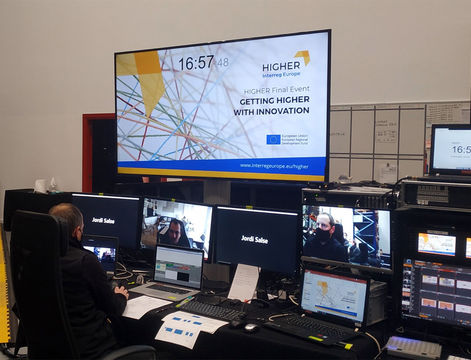
Video of HIGHER Final Event
If you missed the conference "Getting higher with innovation", in which we presented the results of the project, you can watch it on our YouTube channel.
Nine European institutions collaborate in the framework of the Interreg Europe Program for the implementation of HIGHER. The project has the objective to improve the innovation framework and the smart specialization strategy of different EU regions. HIGHER will analyze and exchange experiences and good practices on the management and implementation of regional policy instruments designed to promote the innovation projects under the collaboration between research centers, industry and public authorities.
The HIGHER project is addressed to achieve innovative models of public private partnerships suitable to mobilize investment in related smart specialization areas and fostering an entrepreneurial discovery process in driving innovation process of the policy instruments. This will be achieved through the analysis of nine policy instruments from one of each region involved in the project to promote the innovation projects under public private partnerships. The partners of the project will evaluate these instruments and try to identify which are their main weaknesses, developing a learning process to overcome the main obstacles around them and enhancing a better and more efficient implementation.
Thought basic methods, as workshops, study visits and thematic summits and developed ones, as joint analysis, peer reviews and e-learning modules, the different regions will exchange the experiences and good practices for the future improvement of the policy instruments of each region.
€1,498,656.00
Research and innovation
This instrument is intended to promote the innovation projects under public-private partnerships. Through a co-financing methodology (private companies must invest too) some communities (in different sectors) are being created in order all the stakeholders they include (companies, universities, research centres, public administrations, business associations, etc.) to present a list of actions, projects, methodologies and strategies to work together to develop high innovative projects, promoting the cooperation science – industry. These actionsare developed thanks to the ERDF and also the co-financed part of the communities’ partnerships. The main problem is how to promote the involvement of the companies in these initiatives, for attracting private capital becomes more complicated. Additionally, the collaboration science – industry present special characteristics that must also be studied and addressed to make sure that efficiency is promoted.
This policy instrument aims at speeding up R&D paths in relation to “new social Challenges” (people ageing, climate changes, etc.) through mechanisms which sees the public administration as innovation demand’s driver (e.g. innovative public procurement, vouchers, ICT innovation platforms). This has been a great change in the SF Operational Program approach which needs to be tested, constantly improved and which will greatly benefit of the exchange of experiences with highly developed regions.
The instrument provides co-financement, through innovative procurement procedures, the development of innovative goods and services (not present in the market) produced through the cooperation of SMEs and universities/research centers (public and private), being an example of collaboration among public administration, enterprises and universities/research centers where the public administration has the role of innovation demand driver.
In this context, what must be improved is the qualification of the public administration innovation demand as mean to improve the number of highly innovative companies in regional smart specialisations, but it is also important to improve the quality of project funded and the effectiveness of public expenditures in innovation.
Programme aimed at stimulating the innovation projects in the Stockholm region, based on co-financed structures for the support of strategic collaborations between higher education institutions, research centres, public authorities and the industry. Main activities that are to be funded under the present instrument are related to collaboration to develop new products and services (fostering mobility between different sectors to address cross-sectorial challenges), infrastructure, innovation-related pre-commercial procurement and the development of open data sources in this framework, always related to the smart specialisation strategy.
It is important to increase the innovation efficiency of investments in the new ERDF-period, in terms of new strategic collaborations and development of new innovative products and services in both private and public sector. Stockholm does not have a history of cluster policy and increased knowledge among regional actors about incentives and activities to stimulate innovation collaboration is needed. There is also need for more knowledge on how regional governance initiatives can support these activities. Better policies are also needed to reach the expected targets under the 2020 strategy for innovation (regional, national and European).
This instrument aims to promote business R&D investment, enhancing the cooperation between companies and regional S&T organizations, and stimulating knowledge intensive activities and value creation based on innovation (priority 1.2.1). Specific projects are funded by ERDF (Regional Operational Program – Norte).
A collective approach is privileged; consequently the projects should be oriented to answer to common risks and opportunities of an enlarged group of companies, promoting positive externalities, especially under the challenges established by the regional RIS3. The call for project will be established under subsidies with a co-financing rate.
The instrument should be improved in the following areas: participation of the industry, attraction of private capital to R&D projects, and promotion of a clustering approach (linked to RIS3).
The objective of Inogeb LT is to strengthen the Lithuanian innovation system by creating environment for the spread of knowledge and technology that get enterprises more actively involved in research and development and innovation activities.
The main applicants for this instrument that will deliver the innovation support services are public legal entities (i.e. innovation support agencies, centres, technology parks) and the final beneficiaries are companies, especially newly established technology companies.
In the last programming period the funds for the instrument have been used to partly compensate the expenses related to the provision of the following services: promotion of innovation, innovation partnership, and building demand for innovation support services; technological audits; new product marketing; technology transfer, partner search; provision of advice on innovation process etc.
The need to improve this policy instrument is twofold. On one hand, the Ministry of Economy feels that more impact could be generated from the funds that have been allocated. On other hand, evolution of businesses and their needs clearly indicates that traditional public support services should be more dynamic and versatile. Drawing from the past experience and existing data, the main future challenges for this instrument is related to being relevant to the business, science and society needs and increasing the efficiency and impact of the innovation support services.
This policy instrument aims at co-financing, through Abruzzo’s region ERDF allocation, the realisation of activities in collaboration between the industry and the research institutions and universities, mostly through the involvement of already existent public-private aggregations, such as the Technology Districts, the Public-Private Laboratories, and the Innovation Poles, which are the beneficiaries of the instrument, as well as the industry. Therefore, the projects co-financed are to be developed in a collaborative way in which the applied research industry-science is the base.
With this initiative, the regional authority intends to continue the promotion of the support for the Innovation Poles, the business networks, the clusters, and other similar ventures in order to favour the development of new innovative projects, enhancing the business economic growth after the crisis. Additionally, the instrument intends to foster the construction of international partnerships to work on cutting-edge innovative technologies, enhancing the participation of companies and research institutions from Abruzzo in European projects, such as those under Horizon 2020.
This policy instrument supports strengthening of links and synergies in the innovation system and reinforce cooperation between the knowledge institutions (Universities and research institutes) and economy. The purpose of the instrument is in the areas where Slovenia has recognised comparative and competitive advantages such is: promote knowledge-based development to support productive connection with the research community and industry with the aim of diversifying into new technologies, products and services (the creation of start-up, spin-off, spin-outs, split-off companies and diversification of production in existing enterprises) and, consequently, the creation of jobs with higher added value. The policy instrument will be implemented also through Slovenian Innovation Hub, the new platform that will create new connections and synergies between different knowledge institutions and companies and will create new value chains in different sectors, selected as a priority in the Smart Specialization Strategy, that are to work together under co-financed projects to develop better projects and initiatives. However, given the still low rates of private investments, governance for a better implementation must be developed in order to achieve the expected results.
The instrument is developed under the operational programme for ERDF for Central Macedonia 2014 – 2020 based on promoting business investment in R&I, developing links and synergies between enterprises, research and development centres and the higher education sector, in particular promoting investment in product and service development, technology transfer, social innovation, eco-innovation, public service applications, demand stimulation, clusters and open innovation through smart specialisation, supporting technological and applied research, pilot lines, product validation actions, advanced manufacturing capabilities and first production, in particular in key enabling technologies.
Therefore, under a co-financed scheme, and with the goal of leading to economic growth and jobs creation, public-private partnerships will be developed in order them to establish projects to promote the science-industry collaboration to develop new products, services and processes. This instrument, recently approved, is being finally shaped right now at a regional level due to the circumstances that led it to take more time to be implemented.
Given the contextual situation, especially related to the low rates of investment in innovation, it is obvious that the strategies and instruments of the past were not properly implemented, so learning on better governance models, as well as strategic ones, are needed to make sure that the present policy instrument achieves its objectives.
The instrument aims at promoting business investment in research and innovation between enterprises, research and development centres and the higher education sector, promoting investment in product and service development, technology transfer, social innovation, eco-innovation, public service applications (PCP), demand stimulation, clusters and open innovation through RIS3, supporting technological and applied research, early product validation actions, and advanced manufacturing capabilities, in particular in KETs and diffusion of general purpose technologies.
The objective of the call is to increase investment in research and innovation by companies, particularly in sectors and technologies identified through RIS3. Taking into account this framework, funds will be allocated in projects that work in one or more of these main fields:
• Support for RIS3 collaborative and contract research and development including initiatives stimulating and facilitating productive innovation partnerships
• Initiatives simulating the demand for new or improved services, processes and products including business-led and public procurement programmes
• Collaborative and contract research and development programmes
• Technology support programmes and demonstrator projects and programmes for current and future technologies
The minimum amount of every application (for every project) must be of GBP 400.000 (EUR 560.000 aprox.).

If you missed the conference "Getting higher with innovation", in which we presented the results of the project, you can watch it on our YouTube channel.

On January 28, HIGHER will present experiences and good practices on the management and implementation of regional policies designed to promote innovation.
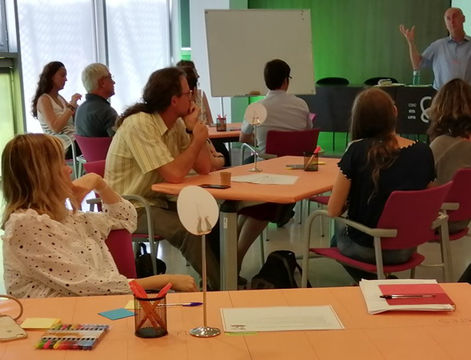
Within the framework of the action plan for Catalonia, UAB Research Park organized a laboratory of ideas to address the challenges of smart food.
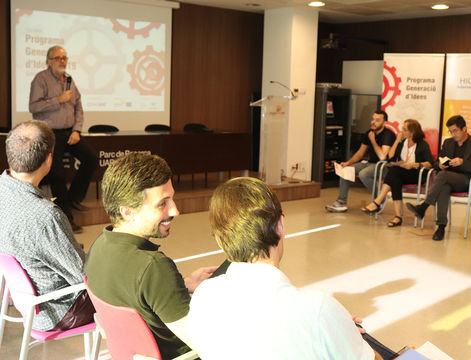
On Wednesday 16 October the Ideas Generation Program on Smart Food began with thirty participants. It is an initiative of the action plan of UAB Research Park.

An action plan oriented to increase the presence of social challenges in catalonia Communities policy instrument.
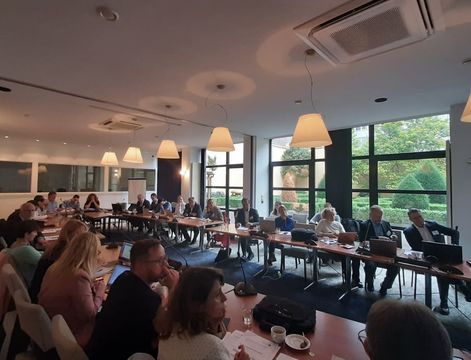
Region of Central Macedonia participated in the thematic workshop "Better Monitoring, Evaluating, and Designing RIS3".

The Regional Scientific Council for R&I of Region of Central Macedonia will be showcased during the next workshop of the Interreg Policy Learning Platform.

The HIGHER partners have engaged in identifying existing good practice cases of Smart Specialisation Strategies, focusing especially on policy instruments.
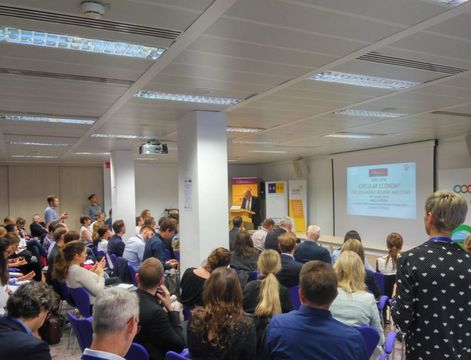
The workshop focused on Circular Economy and Sustainable Development
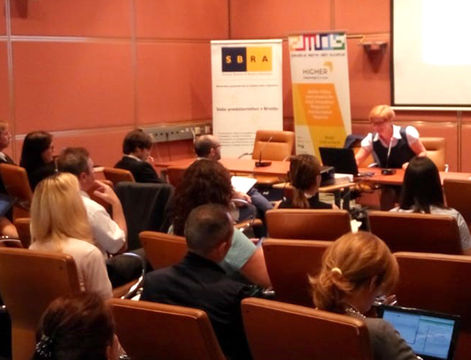
The event was organized on 3rd and 4th July 2018 in Ljubljana by Association of Slovenian Urban Municipalities and Slovenian Business and Research Association.